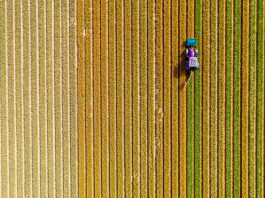Dr Thomas W Gray, from the United States Department of Agriculture’s (USDA) Co-operative Programs, explains why multi-stakeholder co-operatives may be able to bequeath more democratic organisational models and organisations to future generations that can help address sustainability questions and dilemmas.
The nature of the socio-economy in the United States, and nearly all advanced industrial economies, is characterised by socio-economic ‘growthism,’ a worldview where economic growth and an expanding economy are considered imperative to a healthy society and the solution to many societal difficulties.
However, demands for incessant growth also present continuing difficulties and challenges,1 among them concerns about ecological sustainability. as well as tendencies of ‘de-democratisation,’ or the loss of multiple locally owned businesses.
Many rural communities in the US have undergone massive de-democratisations of their socio-economies; now variously populated with big-box stores, franchise chain developments, and acquisitions and subsidiarisations by regional, national, and transnational corporations. Mooney (2004) in Democratizing Rural Economy comments that agricultural co-operatives remain one of the few remaining economic forms in the agricultural and rural sectors that continues to bring democratic voice to rural economies. However, Mooney’s comment does not acknowledge a historic weakening of democratic aspects of agricultural co-operatives, given decades of intense competition with investment-oriented firms (IOFs). These pressures have created various dilemmas within co-operatives themselves, causing many to drift from their more democratic beginnings.
This essay will focus within the agricultural and rural spheres, agricultural co-operatives will be used as a point of reference and familiarisation. The essay will also explore how one: larger pressures of socioeconomic growth and expansion have dimmed some co-ops’ democratic promise; and two: how alternative co-operative forms; e.g., a co-op commonwealth, and multi-stakeholder co-ops, represent possible development models that are more inclusive, resilient, and better designed to accommodate various democratic and social, economic and ecological needs.
Defining principles and difference from IOFs
Agricultural co-operatives are organised around at least three principles:
- The User-Owner Principle: those who own and finance the co-op are those who use the co-op;
- The User-Control Principle: those who control the co-op are those who use the co-op; and
- The User-Benefits Principle: the purpose of the co-operative is to provide and distribute benefits to its users on the basis of their use (Dunn, 1986).2
The most fundamental organisational difference between agricultural co-operatives and investment oriented firms (IOF) is the ‘use’ rationale as highlighted above. For example, dairy farmers ‘use’ dairy co-operatives to assemble, process, and distribute their farm product (milk). In an IOF, the central organisational rationale is return on investment (ROI). Owners have only an ancillary relationship to the actual product/service of the firm. They may own stock in an automobile firm and/or a dairy firm. They likely own a car, and may drink milk, but they in all likelihood do not have a production relationship to the firm. Ownership is not about ‘use’ of the facilities, but rather about making a return on their investment. In contrast, co-operatives must make a financial return over costs to continue to provide a service to their members over time, but it is service provision for use, that is co-ops’ central organising rationale.
An important second organisational difference is voting governance. With some exceptions, most agricultural co-operatives use a ‘one-member, one-vote’ rationale in electing decision makers. IOFs use an aggregative stock-ownership basis — i.e., one vote for each share of stock owned — with no organisational limits on the amount of stock a shareholder may own. Some agricultural co-operatives also permit more than one vote per member. However, it is generally a limited number based on volume transacted with the co-operative. (The most recent research on this matter found over 90% of the largest co-operatives in the US continued to use one-member, one-vote methods (Reynolds, Gray, Kraenzle, 1997). There are several other differences between these two organisational forms outside the focus of this article.
Historical context, internal dilemmas, a weakening democratic ethos
Much of the core of the agricultural co-operative community was formed in the late 19th and early 20th centuries. Important incentives to organise during this period were to oppose or countervail the market power of monopolies/oligopolies (sellers) and monopsonies/oligopsonies (buyers), i.e., market power typically held disproportionately by large IOF firms. More generally, IOFs have become the predominant business form globally, as measured by market share and market power.
IOFs of course compete not only with co-operatives but with each other and other business forms. Within this context, and over time, IOFs have taken on several corporate strategies for survival; among them continued industrialisation, global sourcing and selling, corporate consolidation, market concentration, and integration (both vertically and horizontally), technological intensification, and others. This complexity of concrete forms and functions requires development of large bureaucratic structures ‘for controlling and directing capital among multiples locations and products’ and is accompanied with centralised decision-making, and top-down flows of authority (Gray 2014). Co-ops have adopted parallels to IOF bureaucracies, prompting Fairbarin (1999) to report that their planned survival has been found to depend upon their own ‘expansion, merger, and rationalisation’ and, as such, becoming large bureaucratic organisations in their own right.
These dynamics and their differences and oppositions with IOFs – as played out through powerful market dynamics – have produced a series of tensions within co-operatives akin to a see-saw that that can tip in one direction or another. Three of these tensions include:
- Participation and democracy versus efficiency, capitalism, and bureaucracy;
- Localism versus globalism; and
- Production versus consumption (Gray 2014).
Keep in mind that these tensions are understood as ‘opposing but simultaneously existing tendencies and not as either/or mutually exclusive categories’ (Gray 2014).
Participation and democracy/efficiency, capitalism, bureaucracy
In an IOF, the needs of capital (and the need to make short-term returns on investment) are prioritised over the needs of people as in co-operative use (i.e., user ownership, user-democratic control, user-benefits). Firms in the IOF sphere seek to emphasise capital fluidity, investment, return on investment, and growth. Co-operatives, in seeking to survive, make accommodations within this context. In doing so, they can lose their footing with respect to their commitment to member participation and democratic structure and are given to shifts in emphases to economic efficiency criteria, bureaucratic organisation, and various other emergent trajectories such as horizontal and vertical integration. At times, these tensions can tip toward IOF models to such a degree that conversions to investment-oriented firms occur. For instance, California Olive Growers, Calavo Avocados, Goldkist, American Rice, Dakota Growers Pasta Company, and Saskatchewan, Manitoba, and Alberta wheat pools have all converted to or been acquired by investment firms.
Further, bureaucratic structures typically emphasise centralisation of decision-making and top-down authorities, and at a cost to (though not an elimination of) such co-operative factors as the counter-opposites, i.e. decentralised decision making, bottom-up authorities as well as local member responsiveness, and local participation. Critical expertise is needed to manage these complex organisations, creating asymmetries between management versus members and directors; this organisational space itself resulting in vulnerabilities to such managerial self-agendas as demands for continuing perks, high salaries, and unreasonable job security – often at the expense of member needs and member voice (Sousa and Herman, 2012). In settings of diminished member voice, pressures to shift from one-member, one-vote governance to volume-based voting can occur, and ultimately, as mentioned, an insistence for co-operative conversions to IOFs may emerge, the most severe of de-democratisation tendencies.
Local embeddedness/geographic expansion
Agricultural co-operatives and their farmer-members are closely embedded within their respective localities. While people may move relatively easily, as can manufacturing, farms do not. They are geographically embedded. Centres of agricultural specialisation can, of course, shift geographically, but in a relative sense on a firm basis, co-ops cannot pick up and move in the manner of IOFs. The co-op ‘is’ the farmer-members in a definitional sense.
This embeddedness affords co-operatives certain advantages. It allows for a recognition and a deepening of shared local identities among members. It can help to recruit potential members. Continued commitment to the co-operative itself can be heightened with clarity about local commonalities, mutual interests, and mutual voice about those interests. Uniqueness of local products and local production can be leveraged as a unifier among members as well as a possible specialty in marketing. Embeddedness can also provide some protection against capital flight from a local region during recessionary periods unlike anything afforded by an IOF. In fact, investment-oriented firms find a co-operative kind of embeddedness burdensome, in that it can interfere with the mobility and efficient application of capital (Mooney, 2004).
IOFs have a predominant tendency of expansion in pursuit of ROI – often regionally, nationally, and internationally. Many agricultural co-operatives, to keep pace with corporate ROI rationales, have expanded geographically as well. While this strategy likely adds markets, it often requires standardisation of products across regions. However, standardisation is often accompanied with loss of unique local products, a dilution of local member identity, and a weakening of member commitment to the co-operative. Furthermore, geographic expansion puts distance between members and centres of co-operative decision-making, compounding problems of member voice, member governance and member solidarity; i.e., member democracy.
‘Like the tensions between efficiency and participation, and democracy and capitalism, co-operatives need some degree of both localism and globalism in terms of market development. However, globalist approaches are advised to be taken with caution since an overemphasis on marketing and sales expansion can be accompanied with a series of losses as cited above, particularly a loss of local voice and governance; attributes nearly impossible to obtain without geographic embeddedness,’ (Gray, 2014).
Production/consumption and a co-operative commonwealth
In an economy predominantly organised around the logic of IOFs, production and consumption interests tend to function at competitive and antagonistic poles in a struggle over price and various market advantages. Some of this contention can be muted and prices improved, possibly both for farmers and consumers by creating what Voorhis (2012) has referred to as a co-operative commonwealth. Voorhis states: ‘If a considerable proportion of farm crops [and food] could be sold directly by farmer-owned enterprises to consumer-owned ones, the spread between what farmers receive and what consumers pay would amount … to the costs of processing, transportation, and sale.’ Under this strategy, pecuniary gains garnered by those in the middle between producers and consumers, could be internalised within the commonwealth and made available in an equitable manner among co-operatives and co-operative members.
Furthermore, most if not all business firms seek to minimise the byproduct-costs of operations, e.g., human and environmental costs, by keeping them (or making them) external and not falling within firm accounts. Though not an explicit part of Voorhis’s discussion, a collaborative producer and consumer structure, i.e., a commonwealth, suggests a potential to internalise the costs of externalities with a more inclusive organisational design. Such linked interests are manifest in community supported agriculture, farm-to-school and farm-to-institution agriculture, co-operative farm stores and farmers’ markets, each strongly suggesting the viability of Voorhis-like combinations. While a ‘co-operative commonwealth’ is not a readily recognised narrative in the US, it does anticipate more recent conceptions and developments of ‘multi-stakeholder co-operatives’ (Lund, 2011).
Multi-stakeholder co-operatives
As organisations, multi-stakeholder co-operatives (MSCs) promise a broadened democracy with a voice that is more inclusive of previously externalised groups. ‘A [co-operative] stakeholder is anyone who affects and/or is affected by the organistion and may include such interests as owners, investors, managers, customers, users, employees, lenders, community residents, and community organisations,’ (Gray, 2014). Definitionally, MSCs are generally understood as composed of at least two classes of members, with each group having a set number of seats on a board of directors.
The number of seats is generally determined by the centrality of a particular group to the over-all function of the organisation (Lund, 2011). For example, dairy producers or grain producers would have more seats on a respective cheese making board or a brewery board than external community members. Board functions are typically designed to manage policymaking, strategic planning, and oversight; and more concretely they deal with such issues as ‘deciding what products and service to be involved in, what markets to sell to and buy from, what major capital outlays to make, whether the organisation should expand, close, or move, as well as the hiring and firing of a CEO [and how to relate to the larger community],’ (Cobia, 1989).
MSCs are not free of criticisms. Some authors (Lindsy and Hems, 2004; Monck, 2004) comment that with so many voices to be heard, the organisation can become over-burdened with governance tasks, resulting in conversions to single stakeholder organisations (likely an IOF) or even to a total shut-down and closure. Others have not found this to be the case. Leviten-Reid and Fairbarin (2011) have argued from observed cases, that when membership is broadened beyond products and markets to such larger issues as unemployment, rural outmigration, and environmental quality, for example, member involvement, participation, commitment, trust, and organisational resilience actually deepened. As discussions broadened, divergent opinions actually better mobilised the organisation. By extending democratic voice to a larger panoply of stakeholders, some of the de-democratising processes discussed previously, can be offset with more diverse voices in the larger community.
Conclusion
Alperovitz (2013) in What Then Must We Do? suggests that more democratic forms of ownership – e.g., co-operative commonwealths, multi-stakeholder co-operatives, credit unions – though less prevalent may be in a kind of pre-history, and are likely to become more ascendant if current socioeconomic and ecological conditions continue or worsen. Multi-stakeholder co-operatives, in contrast to IOF firms (and their singular rationality of short term ROI), may be better positioned to consider human and environmental costs within a framework that emphasises ‘use’ and ‘voice.’ Community supported agriculture, farm-to-school, and farm-to-institution agriculture, farm stores and farmers’ markets in fact suggest a pre-history to a broader, more inclusive collaborative economy. If this is to occur in a context of multi-stakeholder co-operatives – and, indeed, in a post-COVID-19 environment where there is a renewed stake in local initiatives and a desire to move away from international supply chains – then larger community energies and commitments might well be mobilised.
If we design organisations with use and democratic characteristics, we might be better positioned as a society to bequeath to future generations both organisational models and organisations that can help address longer-term sustainability imperatives.
Disclaimer
The research ideas presented here are those of the author only and do not necessarily represent the positions of any affiliated agencies or departments.
Thanks go to Anne Todd for editorial assistance on the manuscript.
References
- See Limits to Growth? A perspective on the perpetual debate. Gardner, 2004
2. The ‘use’ principles are highlighted here, rather than those of the ICA, to make explicit the polemic between firms organised around ‘ROI’ and co-ops organised for ‘use’
Additional citations
Cobia, David. Cooperatives in Agriculture. Englewood Cliffs, New Jersey: Prentice Hall. 1989
Gardner, Toby (2004). ‘Limits to Growth? – A Perspective on the Perpetual Debate’. Environmental Sciences, 1:2, 121-138, DOI: 10.1080/15693430512331342592 – https://doi.org/10.1080/15693430512331342592
Gray, Thomas (2014). ‘Historical Tensions, Institutionalization, and the Need for Multi-stakeholder Cooperatives’. Journal of Agriculture, Food Systems, and Community Development. No.3, 2014
Lund, M (2011). Solidarity as a business model: A multistakeholder cooperatives manual. Kent, Ohio: Cooperative Development Center, Kent State University. Retrieved from http://www.oeockent.org
Reynolds, Bruce; Gray, Thomas; Kraenzle, Charles (1997). ‘Voting and Representation Systems in Agricultural Cooperatives’. RB-CS, Research Report 156. Washington, DC: USDA, Rural Business-Cooperative Service
Dunn, J (1986). ‘Basic cooperative principles and their relationship to selected practices’. Journal of Agricultural Cooperation, 3, 83–93
Fairbairn, Brett (1999). History of co-operatives
Sousa, J, & Herman, R (2012). ‘Converting organizational form: An introductory discussion’. In J. Sousa & R. Herman (Eds.), A cooperative dilemma: Converting organizational form (pp. 3–21). Saskatoon: Center for Study of Co-operatives, University of Saskatchewan
Gray, Thomas (2013). ‘Agricultural cooperatives’. In P B Thompson & D M Kaplan (Eds.), Encyclopedia of food and agricultural ethics. Retrieved from https://www.springer.com/gp/book/9789400709287
Mooney, P H (2004). ‘Democratizing rural economy: Institutional friction, sustainable struggle and the cooperative movement’. Rural Sociology, 69(1), 76–98
Voorhis, J (2012). American cooperatives: Where they come from, what they do, where they are going. Whitefish, Montana: Literary Licensing.
Friedmann, H (1995). ‘Food politics: New dangers, new possibilities’. In P McMichael (Ed.), Food and Agrarian Order in the World-Economy (pp. 15–34)
Alperovitz, G (2013).What then must we do? White River Junction, Vermont: Chelsea Green
Wolff, R D (2012). Capitalism hits the fan: The global economic meltdown and what to do about it. Chicago: Haymarket Books
L Leviten-Reid, C, & Fairbairn, B (2011). ‘Multi-stakeholder governance in cooperative organizations: Toward a new framework for research?’ Canadian Journal of Nonprofit and Social Economy Research, 2(2), 25–36
Lindsay, G & Hems, L (2004). ‘The arrival of social enterprise within the French social economy’. Voluntas: International Journal of Voluntary and Nonprofit Organizations, 15(3), 265–286 http://dx.doi.org/10.1023/B:VOLU.0000046281.99367.29
Munkner, H (2004). ‘Multi-stakeholder co-operatives and their legal framework’. In C Borzaga & R Spear (Eds.), Trends and challenges for co-operatives and social enterprises in developed and transition countries (pp. 49–82). Trento, Italy: Edizioni 31
Please note, this article will also appear in the sixth edition of our quarterly publication.









